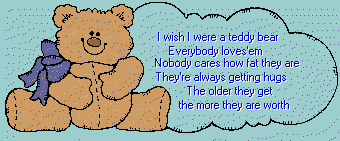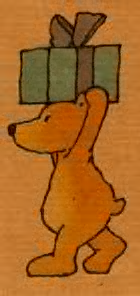
E lke Kraus keeps the eyes in a drawer of her workbench. Black in one box, brown in the middle, and a few blue ones on the right hand side. She also has green and gold eyes, but not many. These, she says, are for animals-particularly cats.
Many patients arrive at her Munich clinic blind in one or both eyes. Others are missing a limb or are bald. Some, over many years, have silently watched their innards seep out.
Kraus operates skillfully with a scalpel and stitches. In a day, new life is breathed back into old skin, tattered ears become whole, amputated limbs are replaced, and the anorexic stuffed with wood shavings. With a knife she cuts off dull eyes and replaces them with new ones. Everything seems to heal around Elke Kraus.
Is there anything sadder or more forlorn than a tired, worn-out, old teddy bear?" she asks, her fingers drawing a dancing thread through the roll of pelt on her workbench. "But when my patients leave, I know they are healthy and strong enough to face another century and all the love and neglect that may mean."
Kraus is
well-known as a teddy bear ![]() maker
and collector. She is also regarded by fellow collectors as something
of a miracle-worker. Her Munich Teddy Bear Clinic is renowned as the
last chance for old bears to receive a new lease of life and teddy
owners the world over eagerly entrust their favorite toys to her not
inexpensive skills.
maker
and collector. She is also regarded by fellow collectors as something
of a miracle-worker. Her Munich Teddy Bear Clinic is renowned as the
last chance for old bears to receive a new lease of life and teddy
owners the world over eagerly entrust their favorite toys to her not
inexpensive skills.
"You can understand why," Kraus says. "For many people, teddy bears are part of their childhood memories and they want them preserved. The price does not matter."
Not only is Munich famous as a center for teddy bear repairs, but it is only an hour and a half from here by car to the place where teddies were invented 93 years ago. Since then, these soft, gentle creatures-from Winnie-the-Pooh down through Rupert and Paddington Bear-have captured the imagination of 20th-century children like no other single toy. And it's not just kids that have been captivated. Like Kraus, many adults, including rock stars, actors, poets and politicians, have fallen under the teddy's peculiar, enticing, psychological spell. Many bears are now collector's items, selling for record prices at toy auctions. And amazingly enough, as we near the end of the century and an age of sophisticated, electronic kid's toys, teddy bears remain the world's most popular toy.

If you go down to the Swabian woods today, you're in for a really big surprise. No, it is unlikely you'll actually find a teddy bear picnic in full swing, but what you will discover is the birthplace of teddy bears. In 1902, in the quiet town of Giengen an der Brenz, northwest of Augsburg, childhood was changed forever. It was here that the first teddy was invented.
The
"inventor," Richard Steiff,  was an innovator and dreamer who had studied
as an artist, and was captivated by bears. He spent many hours in the
bear pits at the Stuttgart Zoological Gardens making sketches and was
determined to produce a toy bear.
was an innovator and dreamer who had studied
as an artist, and was captivated by bears. He spent many hours in the
bear pits at the Stuttgart Zoological Gardens making sketches and was
determined to produce a toy bear.
He worked in his aunt Margarete's small toy factory, the Steiff company. She was a strong-willed woman who, although confined to a wheelchair after an attack of polio in childhood, managed to set up and run the business. "Margarete Steiff was a very loving woman, but she was also very, very strong and determined," says Jörg Junginger, Steiff's development manager and a member of the Steiff family.
"She started the company, building it with nothing but the toys her own two hands could make. At that time, business was seen solely as a man's preserve. It was extremely unusual for a woman, let alone a handicapped woman, to start a business. But Margarete did, and through her determination, she earned the respect of all those she dealt with."
It was to this hard-headed and pragmatic woman that Richard Steiff turned for approval to produce his bear. His aunt and other family members initially opposed the idea, arguing the prototypes were too big and heavy, and the mohair of which they were made was too difficult to obtain. But Richard persisted with his designs and eventually an acceptable model, known as "Friend Petz," was produced and exhibited with other Steiff toys at the Leipzig Toy Fair in 1902-where it was almost a total failure.
"The only
exception was with a buyer for F.A.O. Schwartz, the American toy
giant," says Junginger. "He placed an order for 3,000 bears and
changed the name to 'Teddy' to help the animal appeal to American
children." Exactly why the F.A.O. Schwartz buyer changed the bear's
name is a matter of conjecture, but it seems he was inspired by
then-President of the United States Theodore Roosevelt, who was
affectionately known as![]() "Teddy."
"Teddy."

That was when
teddy bears sales really took off. By 1907, Steiff alone produced
over 974,000 bears, while a host of competitors also cashed in on the
phenomenon. It was not only possible to buy teddy bears in all shapes
and sizes, but there were also teddy bear games, clothes for teddy
boys and teddy girls, as well as carts, cars, boats and automobiles
all especially designed for teddies. Teddy bear images began
appearing on everything from china tea sets to postcards, and teddy
bears were celebrated in songs and books-among them the popular
Winnie-the-Pooh ![]() series, written
in England in 1926.
series, written
in England in 1926.
And it wasn't just in the United States that everyone wanted a teddy. Interest quickly spread around the world, and all these years later, teddy bears are still the top choice of kids worldwide. Indeed, the modern childhood landscape would be a barren place without them.






I am a Member of

BIGGEST Teddy Bear Directory